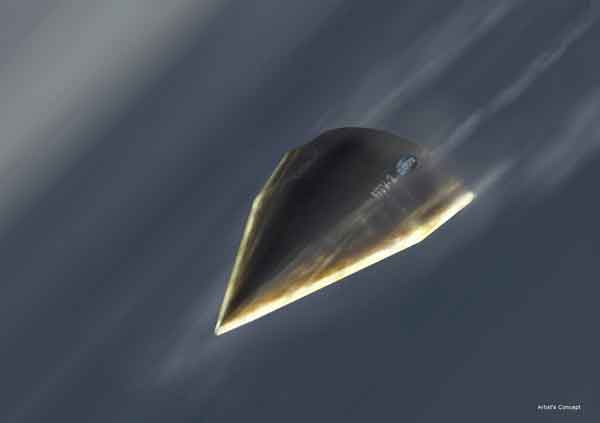It’s amazing that this Hypersonic jet was able to travel more than 13,000 mph with heats of over 3,500 degrees.
During flight it experienced shockwaves, 100 times more powerful than expected, which caused it to spin. It then righted itself and flew for twice as long before technicians finally aborted the mission.
The full story:
In August the Pentagon’s research arm, known as DARPA, carried out a test flight of an experimental aircraft capable of traveling at 20 times the speed of sound.
The arrowhead-shaped unmanned aircraft, dubbed Falcon Hypersonic Technology Vehicle 2, blasted off from Vandenberg Air Force Base, northwest of Santa Barbara, into the upper reaches of the Earth’s atmosphere…then glided above the Pacific at 20 times the speed of sound, or Mach 20.
The plan was for the Falcon to speed westward for about 30 minutes before plunging into the ocean near Kwajalein Atoll, about 4,000 miles from Vandenberg.
But it was ended about nine minutes into flight for unknown reasons. The launch had received worldwide attention and much fanfare, but officials didn’t provide much information on why the launch failed.
via LA Times
Then last week, DARPA said in a statement:
The flight successfully demonstrated stable aerodynamically-controlled flight at speeds up to Mach 20 for nearly three minutes. Approximately nine minutes into the test flight, the vehicle experienced a series of shocks culminating in an anomaly, which prompted the autonomous flight safety system to use the vehicle’s aerodynamic systems to make a controlled descent and splashdown into the ocean.
“The initial shockwave disturbances experienced during second flight, from which the vehicle was able to recover and continue controlled flight, exceeded by more than 100 times what the vehicle was designed to withstand,” said DARPA Acting Director, Kaigham J. Gabriel. “That’s a major validation that we’re advancing our understanding of aerodynamic control for hypersonic flight.”
…larger than anticipated portions of the vehicle’s skin peeled from the aerostructure. The resulting gaps created strong, impulsive shock waves around the vehicle as it travelled nearly 13,000 miles per hour, causing the vehicle to roll abruptly. Based on knowledge gained from the first flight in 2010 and incorporated into the second flight, the vehicle’s aerodynamic stability allowed it to right itself successfully after several shockwave-induced rolls. Eventually, however, the severity of the continued disturbances finally exceeded the vehicle’s ability to recover.
via DARPA
